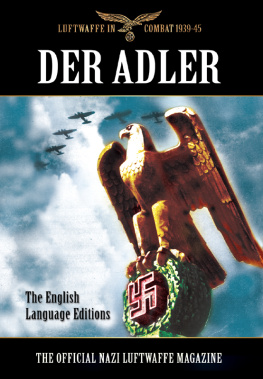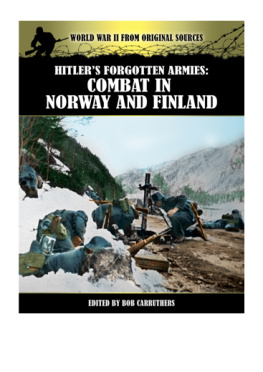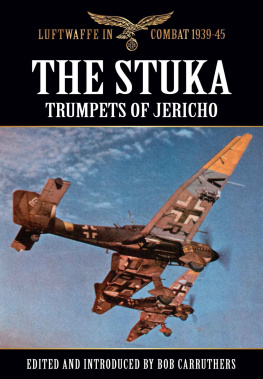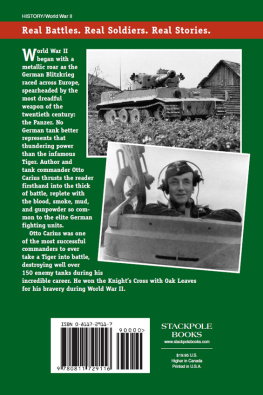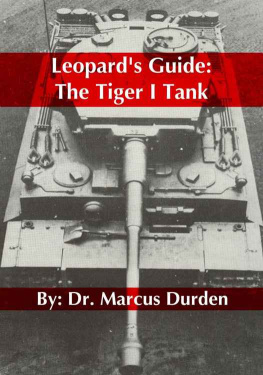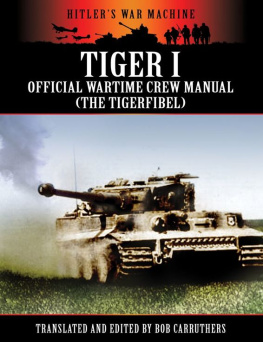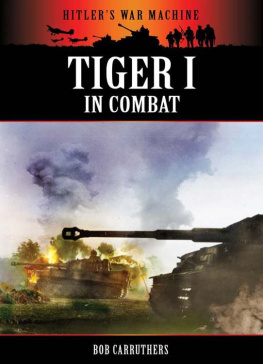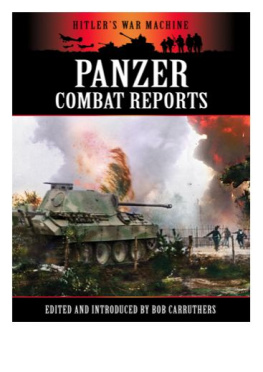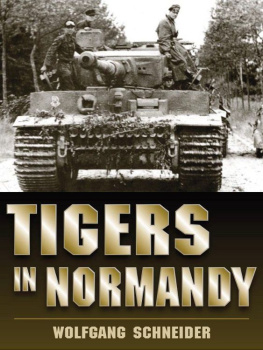


www.codabooks.com
This ebook edition is published in Great Britain in 2012 by
Coda Books Ltd., Office Suite 2, Shrieves Walk, 39 Sheep Street, Stratford-upon-Avon, Warwickshire CV37 6GJ
www.codabooks.com
Copyright 2012 by Coda Books Ltd.
The moral right of Bob Carruthers to be identified as the author of this work has been asserted in accordance with the Copyright, Designs and Patents Act, 1988.
All rights reserved. No part of this publication may be reproduced or transmitted in any form or by any means, electronic or mechanical, including photocopy, recording, or any information storage and retrieval system, without permission in writing from the publisher.
A CIP catalogue record for this book is available from the British Library.
ISBN: 978-1-78158-279-4
I ntroduction
The Tiger I was the most famous heavy tank used in World War II. It was developed in great haste during 1942 by the Henschel & Sohn company as the answer to the unexpectedly formidable Soviet armour encountered during 1941 in the closing stages of Operation Barbarossa. During that titanic campaign an unpleasant surprise for the German armies appeared in the ominous form of the T-34 and the KV-1 to which the German tank designs of the time could provide no answer. The 50mm calibre high velocity gun of the German Mark III lacked projectile mass and penetrating power while the low velocity gun mounted on the German Mark IV was incapable of penetrating the well sloped armour of the T-34 at anything but the shortest range. The high velocity 88mm anti-aircraft gun, which had been forced into action in an anti-tank role in Russia and the western desert, was the only gun which had demonstrated its effectiveness against even the most heavily armoured ground targets such as The KV1.

One of the most famous studies of the Tiger I. This early production model appears to be in almost factory fresh condition.
Rushed into service in August 1942 the Tiger I design at least gave the Panzerwaffe its first tank capable of mounting the fearsome 88mm gun as its main armament. For the hard pressed men of the Panzewaffe however there was a very high price to pay for the Tiger in both literal and metaphorical terms. The highest price of all, or course, was paid by the slave labourers who were forced to build the Tiger.
The Roman numeral I was only officially added in 1944 when the later Tiger II entered production. The initial official German designation was Panzerkampfwagen VI Ausfhrung H (Panzer VI version H), abbreviated to PzKpfw VI Ausf. H. Somewhat confusingly the tank was redesignated as PzKpfw VI Tiger Ausf. E in March 1943. It also enjoyed the ordnance inventory Sonderkraftzug designation SdKfz 181.
The Tiger I first saw action on 22nd September 1942 near Leningrad. It was not an instant success. Under pressure from Hitler, the tank was driven into action in unfavourable terrain, months earlier than planned. Many early models proved to be mechanically unreliable; in this first action most broke down. More worryingly two others were easily knocked out by dug-in Soviet anti-tank guns. Of even more concern was the fact that one disabled tank was almost captured intact by the Soviets. It was finally blown up in November 1942 to prevent it falling into Soviet hands. In any event the Soviets used the battlefield experience well and used the time to study the design and begin to prepare a response which, in due course, would emerge as the fearsome Josef Stalin heavy tank which was to prove equal to the Tiger in every respect.

A Tiger I with the turret number 133 of 1. SS-Pz.-Korps Leibstandarte Adolf Hitler in transit by road march; in the foreground is Schwimmkbel; PK 698.
- Chapter 1
Production of the Tiger

A rare photograph shows the interior of the Tiger I factory Henschelwerk III at Kassel-Mittelfeld.
Production of the Tiger I began in August 1942, and 1,347 were built by August 1944 when production ceased. Production started at a rate of 25 per month and peaked in April 1944 at 104 per month. Battlefield strength peaked at 671 on 1st July 1944. Generally speaking, it took about twice as long to build a Tiger I as any other German tank of the period. However, none of the obvious lessons concerning the need to husband scarce resources were learned and astonishingly when the improved model began production in January 1944, the Tiger I was soon phased out in favour of an even more resource hungry monster in the form of the massive, less efficient and even more resource intense Tiger II.
The major problem with the Tiger I was that it simply used too many scarce resources in terms of both manpower and material, especially when compared with the spartan simplicity of the T-34. As a general rule of thumb each the Tiger I cost over twice as much as a Panzer IV and four times as much as a StuG III assault gun. Each Tiger I actually cost 250,000 Reichsmarks as compared to the 103,500 it cost to manufacture a Panzer IV. The Tiger I was also significantly over engineered which made it difficult to manufacture at a fast rate. The result was an increasing production gap which Speers hard pressed German tank industry could never hope to close. During the Second World War, over 58,000 American Shermans and 36,000 Soviet T-34s were produced, compared to just 1,347 Tiger I and 492 Tiger II. The closest counterpart to the Tiger from the United States was the M26 Pershing around 200 of which deployed during the war and the Soviet IS-2 of which about 3,800 were built during the war.
- Chapter 2
Operational Status

- Chapter 3
The Development Process

Early development prototype hulls for the Henschel heavy tank programme which ultimately produced the Tiger I.
Henschel & Sohn began development of the vehicle that eventually became the Tiger I in January 1937 when the Waffenamt requested Henschel to develop a Durchbruchwagen (breakthrough vehicle) in the 30 metric ton range (see DW 1 hulk opposite). Only one prototype hull was ever built and it never was mounted with a turret. The general configuration and suspension of the Durchbruchwagen prototype in many respects resembled the Panzer III. The proposed turret also bore similarities to existing machines and,had it been completed, it would have greatly resembled the early Panzer IV C turret which sported the short barrelled 7.5cm L/24 cannon.
Before Durchbruchwagen I was completed, however, a new request was issued for a heavier 30 tonne class vehicle with thicker armour; this was known as the Durchbruchwagen II (see VK 6501 opposite). This tank would have carried 50mm of frontal armour and have mounted a Panzer IV turret with the standard 7.5cm L/24 cannon. Overall weight would also have been approximately 36 metric tons. Again only one hull was ever built and a turret was never actually fitted. Development of this vehicle was cancelled in the autumn of 1938 in favour of the more advanced VK3001(H) and VK3601(H) designs. However, both the Durchbruchwagen I and II prototype hulls were used as test vehicles until 1941.
Next page



